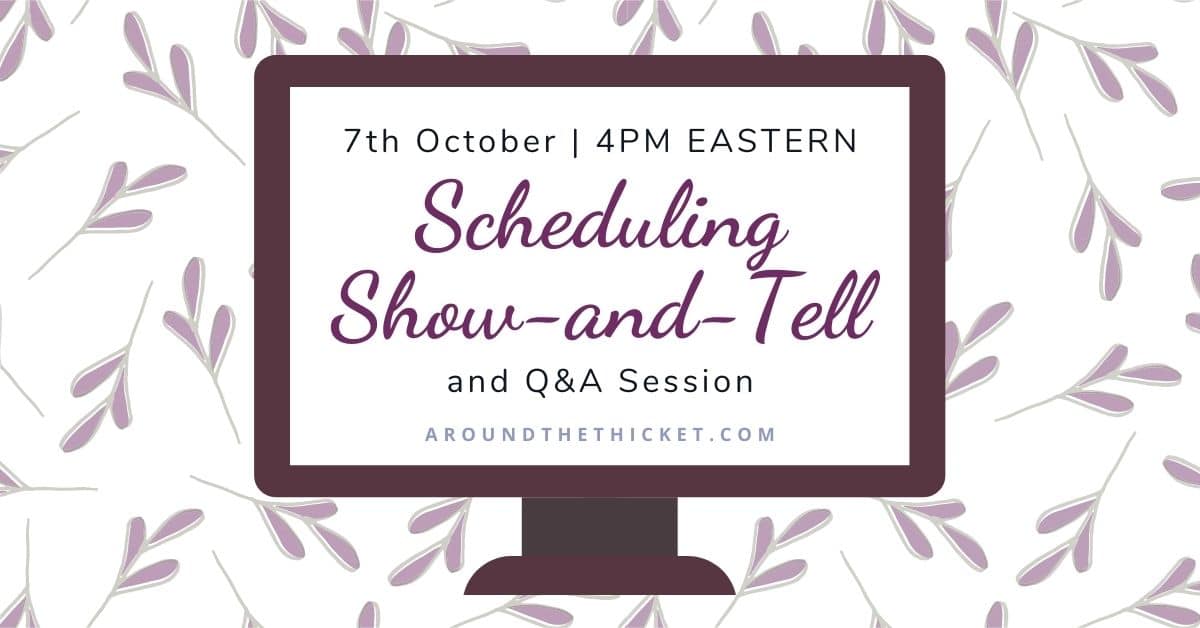What should a homeschool schedule look like?
When we first start homeschooling, we rarely have the benefit of watching other people educate their children on a daily basis (unless, of course, we were home educated ourselves!). We pour over schedules, book lists, and examples of the homeschool days of other families. This can be helpful, but sometimes all the variety can be frustrating. There are so many options and approaches that we wonder what a homeschool schedule should really look like. Which examples should I follow?
While I can’t answer that question for you specifically, I’d like to offer a few guiding principles to help you make that decision for yourself.
(If you’d like to see my homeschool schedule and ask me your scheduling questions, join me live on Zoom on 7th October. For more info, visit my shop.)
A Great Homeschool Schedule Puts First Things First
Last winter, as we headed into our second year of homeschooling, I found myself challenged by a passage in Charlotte Mason’s Home Education, specifically a chapter entitled “Conditions of Healthy Brain-Activity“.
Some of this chapter is out-dated (rigorous airing of rooms isn’t as vital when you are not heating your home with coal fires). Still, children have changed little since Miss Mason’s time. They have the same “basic needs” that we should meet before lessons. These include: proper rest, proper nourishment, variety in activity, companionship, fresh air and exercise. She concludes the chapter with these words:
“I fear the reader may be inclined to think that I am inviting his attention for the most part to a few physiological matters––the lowest round of the educational ladder. The lowest round it may be, but yet it is the lowest round, the necessary step to all the rest. For it is not too much to say that, in our present state of being, intellectual, moral, even spiritual life and progress depend greatly upon physical conditions.”
Do our children struggle to sit for lessons? Are they young and, as I like to say, full of beans? If we rush to get to school, and ignore the physiological needs of our children, we may make things more difficult for ourselves and our kids.
It is a step of faith to adjust our plans around this lowest “round” or rung of the ladder is actually necessary and, in a sense, more important than reading our books, because if we miss out that rung, we will falter and fumble our way. The books and lessons will be less effective than they could be. Our homeschool schedules should acknowledge that care for their physical selves is essential to every other hope we hold for our kids.

A Homeschool Schedule Should Take Us Toward Our Goals
What are our reasons for homeschooling? What are our goals? Charlotte Mason (an educational philosopher from the Victorian Era) wrote that “Method implies two things––a way to an end, and a step by step progress in that way.” We should firmly orient our homeschool schedules toward our goals. Our schedules should help us make progress, step by step, in the direction we want to go.
For example, one long-term reason I home educate is that I want my children to keep their intrinsic love of learning as they grow up. I hope they find reading and learning delightful as adults. If this is my hope, then in the short term, I need to give my children knowledge and ideas that whet their appetite for more. They need lessons that reach their imaginations.
This plays out in my schedule. I don’t make lessons too long, and I fill them up with excellent literature, narrative history lessons, geography stories that transport my children around the world. I mix these things up with their math lessons, singing, art, and poetry. There is so much beauty in the world, and bringing it into my homeschool is a guiding theme.
As I discussed in a recent podcast, any homeschool schedule should serve our top priorities, and bring us closer to our goals. If our goal is to build up a child’s habit of attention, we will need to adjust the length of our lessons to stretch and grow their attention span – starting short and gradually getting longer. If we want our children to care about creation, we will prioritize time spent on nature walks, gardening, and outdoor play. I encourage you to look at your current schedule. What does it say about your values, your hopes, and your priorities? Do these match what you want them to be?
A Homeschool Schedule Should Reflect Your Current Reality
Homeschools are not classrooms. We are teachers, yes, but we are also caring for younger siblings, answering the door, trying to tidy up breakfast, and we have dinner plans in the back of our minds. If we don’t schedule for how our lives really are at the moment, we will have our plans scuppered and our hopes dashed.
Particularly when we have younger families, it helps to plan for flexibility. For me, this means that I never put times on my daily plans. I never know when we’ll finish breakfast, and hence, I don’t know what time we’ll start our first lessons. I know that we’ll have interruptions, but who knows how many and for how long. Please don’t ask what time we’ll finish lessons for the day. I don’t know. Punctuality is a lesson my children will learn through other means (like arriving to group meetings or at church on time). At home, we are all learning understanding and patience.
We also need to tune in to where our children are in their learning, their habits, their physical abilities. Our kids may be bright, but need help to build a habit of paying attention to their lessons. Or perhaps our children are older. They need to spend more time studying and learning. Maybe everyone (including mom) needs a recess part way through the morning.
Swiss educational reformer Johann Pestalozzi founded his schools on the idea that education is organic. A child learns and grows from where that child already is. Our schedules should reflect where our children are right now. Therefore, there are no set-in-stone rules about how a homeschool schedule should look, because our children are all in different places. In fact, this is one of the beautiful benefits of home education: we can adjust our plans around where our children actually are rather than an average of all the children in the room.
Find Your Feet in Homeschool Scheduling
It takes time to build up our knowledge and experience in home educating, and it takes time to gain confidence in our scheduling. We can put ourselves in a better position by looking at what other people do, by considering our big picture reasons for home educating, and by thoughtfully considering where our children are in their development. Perhaps the most important principle we can apply is one of embracing trial and error, accepting that it’s our experience ‘on the ground’ that will help us the most.

Did you enjoy this post? Consider supporting me on Ko-fi!
Want to find your feet with the Charlotte Mason Way?

Grab my eight day mini course on the Charlotte Mason Essentials when you subscribe to my newsletter. You’ll get daily emails, a mini podcast series, and a printable workbook with reading assignments and action steps. You’ll be on your Charlotte Mason journey in no time!








